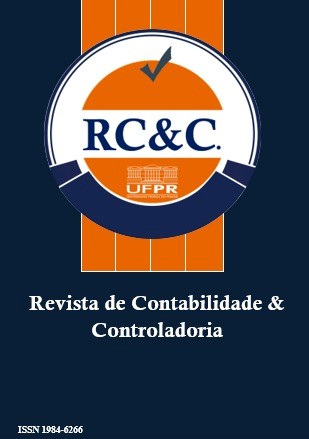Recomendações Para Ampliação do TDABC: Estudo de Caso em Centro de Esterilização Hospitalar
DOI:
https://doi.org/10.5380/rcc.v16i1.89473Palavras-chave:
TDABC, Custeio, Gestão, Teoria da Contingência.Resumo
O custeio TDABC é uma ferramenta que auxilia na tomada de decisão. Na área da saúde verifica-se concentração de estudos focando na identificação de custos de procedimentos e/ou pacientes. Com intuito de dar um enfoque diferente, voltado às unidades de apoio internas de hospitais, bem como possibilitar a utilização do TDABC como instrumento amplo de gestão, o estudo teve o objetivo de propor uma lista de recomendações para implementação do custeio TDABC nas unidades de apoio de um hospital. Trata-se de um estudo de caso, realizado ao longo dos anos de 2021 e 2022, cujos dados coletados em relatórios, questionários, observações e entrevistas foram submetidos à análise de conteúdo. Embora as entrevistas e questionários tenham sido direcionadas para o corpo gerencial, os técnicos também forneceram dados para pesquisa. As análises aconteceram, predominantemente, no centro de esterilização (CME) e os fatores de contexto do hospital foram examinados com sustentação na Teoria da Contingência. Assim, a partir da identificação dos fatores contingenciais que envolvem o hospital e da aplicação do custeio TDABC no processo de roupas cirúrgicas do CME, propôs-se uma lista de recomendações para apoiar a implantação da ferramenta nas demais unidades de apoio do hospital. A lista de recomendações proposta divide-se em dois blocos (planejamento e execução) e privilegia as nuances específicas do hospital.
Referências
Ahmadi E., Masel D. T., & Hostetler S. (2019). A robust stochastic decision-making model for inventory allocation of surgical supplies to reduce logistics costs in hospitals: A case study. Operations Research for Health Care, 20, 33-44. https://doi.org/10.1016/j.orhc.2018.09.001
Akhavan, S., Ward, L., & Bozic, K. J. (2016). Time-driven activity-based costing more accurately reflects costs in arthroplasty surgery. Clinical Orthopaedics and Related Research, 474(1), 8-15. https://doi.org/10.1007/s11999-015-4214-0
Al-Nuaimi, S. I. M., Mohamed, R., &, Alekam, J. M. E. (2017). The link between information technology, activity-based costing implementation and organizational performance. International Review of Management and Marketing, 7(1), 452-457. https://bityli.com/JVfEds
Al-Sayed, M., & Dugdale, D. (2016). Activity-based innovations in the UK manufacturing sector: Extent, adoption process patterns and contingency factors. The British Accounting Review, 48, 38-58. https://doi.org/10.1016/j.bar.2015.03.004
Amara, T., & Benelifa, S. (2017). The impact of external and internal factors on the management accounting practices. International Journal of Finance and Accounting, 6(2), 46-58. https://doi.org/10.1108/AJAR-08-2018-0023
Anderson, D. M., Cronk, R., Best, L., Radin, M., Schram, H., Tracy, J. W, & Bartram, J. (2020). Budgeting for environmental health services in healthcare facilities: A ten-step model for planning and costing. International Journal of Environmental Research and Public Health, 17, 1-22. https://doi.org/10.3390/ijerph17062075
Baird, K. M., Harrison, G. L., & Reeve, R. C. (2004). Adoption of activity management practices: a note on the extent of adoption and the influence of organizational and cultural factors. Management Accounting Research, 15, 383–399. https://doi.org/10.1016/j.mar.2004.07.002
Baird, K. M., Harrison, G. L., & Reeve, R. C. (2007). Success of activity management practices: The influence of organizational and cultural factors. Accounting and Finance, 47, 47–67. https://doi.org/10.1111/j.1467-629X.2006.00195.x
Bardin, L. (1980). L’analyse de contenu. Presses Universitaire de France.
Barros, R. S., & Ferreira, A. M. D. S. C. (2017). Time-driven activity-based costing: designing a model in a portuguese production environment. Qualitative Research in Accounting & Management, 14(1), 2-20. https://doi.org/10.1108/QRAM-10-2015-0095
Bernstein, D. N., Wright, C. L., Lu, A., Kim, C., Warner, J. J. P., & O’Donnell, E. A. (2023). Surgeon idiosyncrasy is a key driver of cost in arthroscopic rotator cuff repair: a time-driven activity-based costing analysis. Journal of Shoulder Elbow Surgery, 32, 616–623. https://doi.org/10.1016/j.jse.2023.05.008
Cescon, F., Costantini, A., & Grassetti, L. (2019). Strategic choices and strategic management accounting in large manufacturing firms. Journal of Management and Governance. 23, 605-636. https://doi.org/10.1007/s10997-018-9431-y
Chenhall, R. H. (2003). Management control systems design within its organizational context: Findings from contingency-based research and directions for the future. Accounting, Organizations and Society, 28, 127–168. https://doi.org/10.1016/S0361-3682(01)00027-7
Chenhall, R. H. (2004). The role of cognitive and affective conflict in early implementation of activity-based cost management. Behavioral Research in Accounting. 16, 19-44. https://doi.org/10.2308/bria.2004.16.1.19
Demeere, N., Stouthuysena, K., & Roodhooft F. (2009). Time-driven activity-based costing in an outpatient clinic environment: Development, relevance and managerial impact. Health Policy, 92, 296-304. https://doi.org/10.1016/j.healthpol.2009.05.003
Dixon, R., & Smith, D. R. (1993). Strategic management accounting. Omega, 21(6), 605-18. https://doi.org/10.1016/0305-0483(93)90003-4
Elshaer, A. M. (2020). Analysis of restaurants’ operations using time-driven activity-based costing (TDABC): Case study. Journal of Quality Assurance in Hospitality & Tourism, 1-24. https://doi.org/10.1080/1528008X.2020.1848745
Etges, A. P. B. S., Cruz, L. N., Notti, R. K, Neyeloff, J. L., Schlatter, R. P., Astigarraga, C. C., Falavigna, M, & Polanczyk, C. A. (2019). An 8‑step framework for implementing time‑driven activity‑based costing in healthcare studies. The European Journal of Health Economics, 20, 1133-1145. https://doi.org/10.1007/s10198-019-01085-8
Etges, A. P. B. S., Polanczyk, C. A., & Urman, R. D. (2020). A standardized framework to evaluate the quality of studies using TDABC in healthcare: The TDABC in healthcare consortium consensus statement. BMC Health Services Research, 20(1), 1-15. https://doi.org/10.1186/s12913-020-05869-0
Evans, J. H., III, Lewis, B. L, & Patton, J. M. (1986). An economic modeling approach to contingency theory and management control. Accounting Organizations and Society, 11(6), 483-498. https://doi.org/10.1016/0361-3682(86)90032-2
Fei, Z. Y, & Isa, C. R. (2010). Factors influencing activity-based costing success: A research framework. International Journal of Trade, Economics and Finance, 1(2), 144-150. https://doi.org/10.7763/IJTEF.2010.V1.26
Gervais, M., Levant, Y., & Ducrocq, C. 2010. Time-driven activity-based costing (TDABC): An initial appraisal through a longitudinal case study. Journal of Applied Management Accounting Research, 8(2), 1-20. https://bityli.com/qQUuOj
Gosselin, M. (1997). The effect of strategy and organizational structure on the adoption and implementation of activity-based costing. Accounting, Organizations and Society, 22(2), 105-122. https://doi.org/10.1016/S0361-3682(96)00031-1
Gulati, S., During, D., Mainland, J., & Wong, A. M. F. (2018). Using the time-driven activity-based costing model in the eye clinic at the hospital for sick children: A case study and lessons learned. Helthcare Quarterly, 20(4), 48-53. https://doi.org/10.12927/hcq.2018.25423
Hadid, W., & Al-Sayed, M. (2021). Management accountants and strategic management accounting: The role of organizational culture and information systems. Management Accounting Research, 50, 1-17. https://doi.org/10.1016/j.mar.2020.100725
Haldma, T., & Lääts, K. (2002). Contingencies influencing the management accounting practices of Estonian manufacturing companies. Management Accounting Research, 13, 379–400. https://doi.org/10.1006/mare.2002.0197
Hammad, S. A., Jusoh, R., & Oon, E. Y. N. (2010). Management accounting system for hospitals: A research framework. Industrial Management & Data Systems. 110(5), 762-784. https://doi.org/10.1108/02635571011044777
Hoozée, S., Vermeire, L., & Bruggeman, A. (2012). The impact of refinement on the accuracy of time-driven ABC. ABACUS, 48(4), 439-472. https://doi.org/10.1111/j.1467-6281.2012.00366.x
Innes, J., & Mitchell, F. (1995). A survey of activity-based costing in the U. K.’s largest companies. Management Account Research, 6, 137-153. https://doi.org/10.1006/mare.1995.1008
Kaplan, R. S. (1984). The evolution of management accounting. The Accounting Review, 59(3), 390-418. https://bityli.com/ZBZyLc
Kaplan, R. S., & Witkowski, M. L. (2014). Better accounting transforms health care delivery. Accounting Horizons, 28(2), 365-383. https://doi.org/10.2308/acch-50658
Kaplan, R., & Anderson, S. (2004). Time-driven activity-based costing. Harvard Business Review. 82, 131-138. https://bityli.com/wDZYgD
Kaplan, R., & Anderson, S. (2007). Time-driven activity-aased costing. Harvard Business School Press.
Keel, G., Savage, C., Rafiq, M., & Mazzocato, P. (2017). Time-driven activity-based costing in health care: A systematic review of the literature. Health Policy, 121, 755-763. https://doi.org/10.1016/j.healthpol.2017.04.013
Kefea, I., & Taniș, V. N. (2023). The integration of the theory of constraints and the time driven activity-based costing system for the improvement of production processes in an SME. Revista de Contabilidad Spanish Accounting Review, 26(1), 3-13. https://www.doi.org/10.6018/rcsar.413411
Langfield-Smith, K. (1997). Management control systems and strategy: A critical review. Accounting, Organizations and Society, 22(2), 207-232. https://doi.org/10.1016/S0361-3682(95)00040-2
Langfield-Smith, K. (2008). Strategic management accounting: How far have we come in 25 years?. Accounting, Auditing & Accountability Journal, 21(2), 204-228. https://doi.org/10.1108/09513570810854400
McBain, R. K., Jerome, G., Warsh, J., Browning, M., Mistry, B., Faure, P. A. I., Pierre, C., Fang, A. P., Mugunga, J. C., Rhatigan, J., Leandre, F., & Kaplan, R. (2016). Rethinking the cost of healthcare in low-resource settings: The value of time-driven activity-based costing. BMJ Global Health, 1, 1-7. https://doi.org/10.1136/bmjgh-2016-000134
Mercier, G., & Naro, G. (2014). Costing hospital surgery services: The method matters. Plos One, 9(5), 1-7. https://doi.org/10.1371/journal.pone.0097290
Moons, K., Waeyenbergh, G., & Pintelon, L. (2019). Measuring the logistics performance of internal hospital supply chains – A literature study. Omega, 82, 205-217. https://doi.org/10.1016/j.omega.2018.01.007
Nguyen, T. H., Nguyen, D. T., Nguyen, T. A., & Nguyen, C. D. (2023). Impacts of contingency factors on the application of strategic management accounting in vietnamese manufacturing enterprises. Cogent Business & Management, 10(2), 1-28. https://doi.org/10.1080/23311975.2023.2218173
Otley, D. (2016). The contingency theory of management accounting and control:1980–2014. Management Accounting Research, 31, 45-62. https://doi.org/10.1016/j.mar.2016.02.001
Otley, D. T. (1980). The contingency theory of management accounting: Achievement and prognosis. Accounting, Organizations and Society. 5(4), 413-428. https://doi.org/10.1016/0361-3682(80)90040-9
Pavlatos, O. (2018). Strategic cost management, contingent factors and performance in services. Accounting and Management Information Systems, 17(2), 215-233. https://doi.org/10.24818/jamis.2018.02002
Pierce, B., & Brown, R. (2006). Perceived success of costing systems: Activity-based and traditional systems compared. The Journal of Applied Accounting Research, 8, 108-161. https://doi.org/10.1108/96754260680001046
Pizzini, M. J. (2006). The relation between cost-system design, managers' evaluations of the relevance and usefulness of cost data, and financial performance: An empirical study of US hospitals. Accounting, Organizations and Society, 31, 179–210. https://doi.org/10.1016/j.aos.2004.11.001
Rahman, M. S. A., Mohamad, E., & Rahman, A. A. A.(2019). Enhancement of time-driven activity–based costing (TDABC) by using simulation in manufacturing process towards industry 4.0. International Journal of Innovative Technology and Exploring Engineering, 8(10), 1895-1900. https://doi.org/10.35940/ijitee.J9243.0881019
Rankin, R. (2020). The predictive impact of contextual factors on activity-based costing adoption. Journal of Accounting and Finance, 20(1), 66-81. https://doi.org/10.33423/jaf.v20i1.2742
Salancik, G. R., & Pfeffer, J. (1974). The bases and use of power in organizational decision making: The case of a university. Administrative Science Quarterly, 19(4), 453-473. https://doi.org/10.2307/2391803
Stout, D. E., & Propri, J. M. (2011). Implementing time-driven activity-based costing at a medium-sized electronics company. Management Accounting Quarterly, 12(3), 1-11. https://bityli.com/euZMa
Sung, S. Y., & Choi, J. N. (2023). What drives firms to invest in training and developing employees? time-dependent effects of firm internal and external contingencies. The International Journal of Human Resource Management, 34(2), 223-252. https://doi.org/10.1080/09585192.2021.1965007
Waterhouse, J. H., & Tjessen, P. (1978). A contingency framework for management accounting systems research. Accounting, Orgrnizations and Society, 3(1), 65-76. https://doi.org/10.1016/0361-3682(78)90007-7
Xu, K., Soucat, A., Kutzin, J., Siroka, A., Garcia, M. A., Dupuy, J., Eigo, N., Li, D., Indikadahena, C., Touré, H., Barroy, H., & Flores, G. (2019). Global spending on health: A world in transition. World Health Organization. https://bityli.com/gfxQHe
Yin, R. K. (2009). Case study research: Design and methods. Sage.
Downloads
Publicado
Como Citar
Edição
Seção
Licença
Copyright (c) 2024 RC&C. Revista de Contabilidade e Controladoria

Este trabalho está licenciado sob uma licença Creative Commons Attribution-NonCommercial-NoDerivatives 4.0 International License.
Os trabalhos publicados na RC&C. Revista de Contabilidade e Controladoria estão sujeitos aos seguintes termos:
1.1. A RC&C. Revista Contabilidade & Controladoria, através do Programa de Pós-Graduação em Contabilidade do Departamento de Contabilidade - Setor de Ciências Sociais Aplicadas - Universidade Federal do Paraná, retém os direitos de propriedade (direitos autorais) dos trabalhos publicados e incentiva e permite sua reutilização sob a Licença Creative Commons 4.0 de CC Attribution-NonCommercial-ShareAlike 4.0, para que possam ser copiados, utilizados, disseminados, transmitidos e exibidos publicamente, desde que:
1.1.a. A autoria e a fonte original da publicação (periódico, editora, URL e DOI do trabalho) sejam citadas.
1.1.b. Não sejam utilizados para fins comerciais ou onerosos.
1.1.c. A existência e as especificações desta licença de uso são mencionadas.
1.2. A publicação atribuirá a cada artigo um Identificador de Objeto Digital (DOI).









